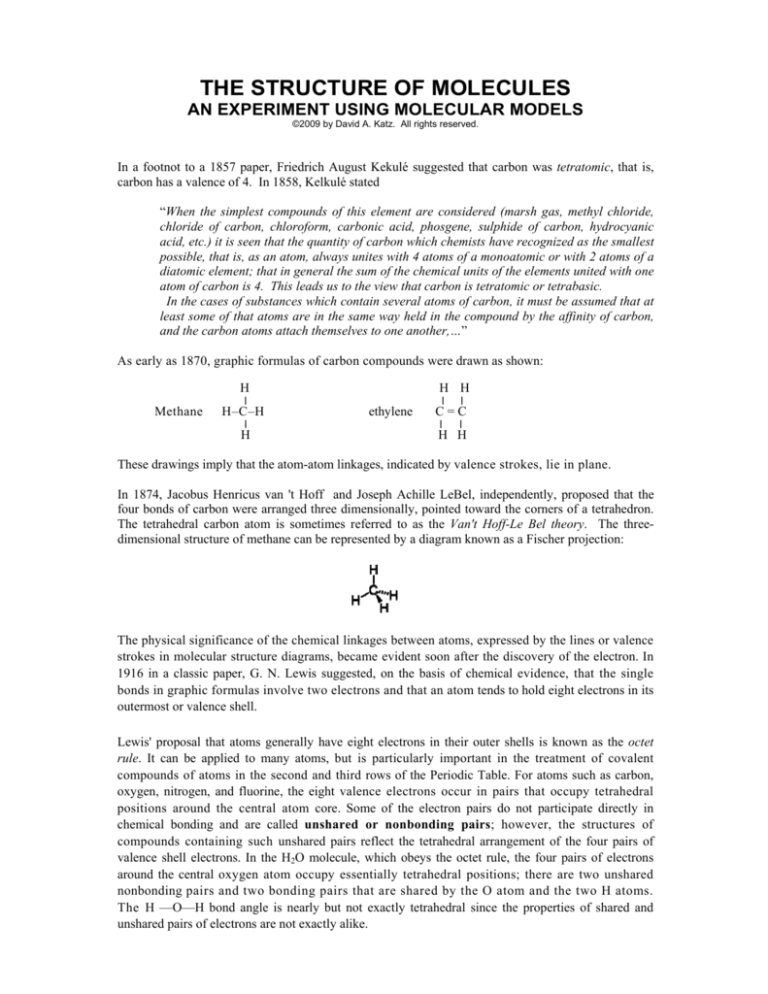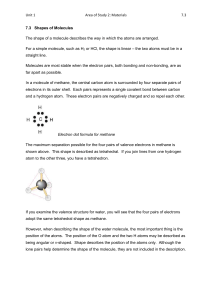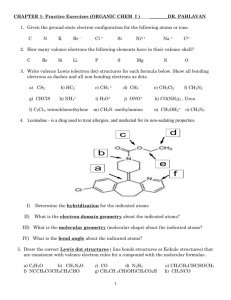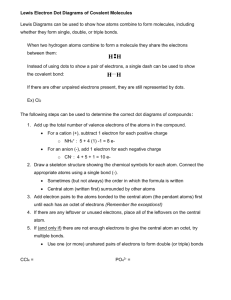
THE STRUCTURE OF MOLECULES
AN EXPERIMENT USING MOLECULAR MODELS
©2009 by David A. Katz. All rights reserved.
In a footnot to a 1857 paper, Friedrich August Kekulé suggested that carbon was tetratomic, that is,
carbon has a valence of 4. In 1858, Kelkulé stated
“When the simplest compounds of this element are considered (marsh gas, methyl chloride,
chloride of carbon, chloroform, carbonic acid, phosgene, sulphide of carbon, hydrocyanic
acid, etc.) it is seen that the quantity of carbon which chemists have recognized as the smallest
possible, that is, as an atom, always unites with 4 atoms of a monoatomic or with 2 atoms of a
diatomic element; that in general the sum of the chemical units of the elements united with one
atom of carbon is 4. This leads us to the view that carbon is tetratomic or tetrabasic.
In the cases of substances which contain several atoms of carbon, it must be assumed that at
least some of that atoms are in the same way held in the compound by the affinity of carbon,
and the carbon atoms attach themselves to one another,…”
As early as 1870, graphic formulas of carbon compounds were drawn as shown:
Methane
H
׀
H–C–H
׀
H
ethylene
H H
׀ ׀
C=C
׀ ׀
H H
These drawings imply that the atom-atom linkages, indicated by valence strokes, lie in plane.
In 1874, Jacobus Henricus van 't Hoff and Joseph Achille LeBel, independently, proposed that the
four bonds of carbon were arranged three dimensionally, pointed toward the corners of a tetrahedron.
The tetrahedral carbon atom is sometimes referred to as the Van't Hoff-Le Bel theory. The threedimensional structure of methane can be represented by a diagram known as a Fischer projection:
The physical significance of the chemical linkages between atoms, expressed by the lines or valence
strokes in molecular structure diagrams, became evident soon after the discovery of the electron. In
1916 in a classic paper, G. N. Lewis suggested, on the basis of chemical evidence, that the single
bonds in graphic formulas involve two electrons and that an atom tends to hold eight electrons in its
outermost or valence shell.
Lewis' proposal that atoms generally have eight electrons in their outer shells is known as the octet
rule. It can be applied to many atoms, but is particularly important in the treatment of covalent
compounds of atoms in the second and third rows of the Periodic Table. For atoms such as carbon,
oxygen, nitrogen, and fluorine, the eight valence electrons occur in pairs that occupy tetrahedral
positions around the central atom core. Some of the electron pairs do not participate directly in
chemical bonding and are called unshared or nonbonding pairs; however, the structures of
compounds containing such unshared pairs reflect the tetrahedral arrangement of the four pairs of
valence shell electrons. In the H2O molecule, which obeys the octet rule, the four pairs of electrons
around the central oxygen atom occupy essentially tetrahedral positions; there are two unshared
nonbonding pairs and two bonding pairs that are shared by the O atom and the two H atoms.
The H —O—H bond angle is nearly but not exactly tetrahedral since the properties of shared and
unshared pairs of electrons are not exactly alike.
Essentially, all organic molecules obey the octet rule, and so do most inorganic molecules and
ions. For species that obey the octet rule it is possible to draw electron-dot, or Lewis, structures.
The drawing of the H 2 O molecule, above, is an example of a Lewis structure.
In a Lewis structure there are eight electrons around each atom (except for H atoms,
which always have two electrons) Group 2A atoms which form 2 bonds have 4
electrons and Group 3A atoms which form 3 bonds have 6 electrons.
There are two electrons in each bond (designated by a line).
When counting electrons in these structures, one considers the electrons in a bond between
two atoms as belonging to the atom under consideration. Thus, electrons may be counted
twice, once for each atom in the bond.
The bonding and nonbonding electrons in Lewis structures are all from the outermost shells of
the atoms involved, and are the so-called valence electrons of those atoms.
For the main group elements, the number of valence electrons in an atom is equal to the
group number of the element in the Periodic Table. Hydrogen in Group 1 has one valence
electron, carbon, in Group 4, has four valence electrons, and chlorine, in Group 7, has seven
valence electrons.
In an octet rule structure the valence electrons from all the atoms are arranged in such a way
that each atom, except hydrogen and the Group 2 and Group 3 atoms, have eight electrons.
Construction of an octet rule structure for a molecule can be accomplished by counting the
number of electrons. Using water as an example, an oxygen atom has six valence electrons
(Group 6) and a hydrogen atom has one, the structure would need one O and two H atoms
have a total of eight valence electrons; the octet rule structure for H 2O can be observed in the
structure shown earlier. Structures like that of H2O, which involve only single bonds and nonbonding
electron pairs, are common. Sometimes, however, there is a "shortage" of electrons; that is, it is not
possible to construct an octet rule structure in which all the electron pairs are either in single
bonds or are nonbonding pairs. Ethene or ethylene, C 2H4, is a typical example of such a species.
In such cases, octet rule structures can often be made in which two atoms are bonded by two
electron pairs, rather than one pair. The two pairs of electrons form a double bond. In the
C2H4 molecule, shown below, the C atoms each get four of their electrons from the double bond.
The assumption that electrons behave this way is supported by the fact that the C=C double
bond is both shorter and stronger than the C—C single bond in the C 2H6 molecule. Double
bonds, and triple bonds, occur in many molecules, usually between C, O, N, and/or S atoms.
Ethene or ethylene
H H
׀ ׀
C=C
׀ ׀
H H
Lewis structures can be used to predict molecular and ionic geometries by assuming that the
four pairs of electrons around each atom are arranged tetrahedrally. This is the method used to
determine the geometry for H 2 O. In the C 2 H 4 molecule, the shape around each carbon atom is
triangular (or trigonal) planar. (The two bonding pairs in the double bond are not lined up
between the two nuclei, but are spread out in space above and below the plane of the
molecule). In describing molecular geometry we indicate the positions of the atomic nuclei, not
the electrons.
The idea of a correlation between molecular geometry and number of valence electrons (both shared
and unshared) was first presented in 1940 by Sidgwick and Powell. In 1957, R. J. Gillespie and R. S.
Nyholm refined this concept to build a more detailed theory capable of choosing between various
alternative geometries. This theory is known as the Valence Shell Electron Repulsion Theory
(VSEPR).
The VSEPR theory assumes
1. The electron pairs in the valence shell of a central atom repel each other.
2. The electron pairs occupy positions in space that minimize repulsions and maximize the
distance of separation between them. (i.e., they are as far away from each other as possible)
3. The valence shell is treated as a sphere with electron pairs spread out on the spherical surface
at maximum distance from one another.
4. A multiple bond is treated as if it is a single electron pair for determining the molecular
geometry. There are some additional effects of the two or three electron pairs of a multiple
bond on the actual bond angles.
5. Where two or more resonance structures can depict a molecule the VSEPR model is
applicable to any such structure.
Three types of repulsion take place between the electrons of a molecule:
1. The lone pair-lone pair repulsion
2. The lone pair-bonding pair repulsion
3. The bonding pair-bonding pair repulsion.
The VSEPR shapes for compounds formed from Group 2 to Group 6 atoms are given in Table 1
In addition to the common VSEPR shapes for the Group 5 and Group 6 elements, these elements
may form structures that violate the octet rule by having 5 or 6 bonds to the central atom. Some
examples of these molecules are given in Table 2.
It is also possible to predict polarity from Lewis structures. Polar molecules have their center of
positive charge at a different point than their center of negative charge. This separation of charges
produces a dipole moment in the molecule. Covalent bonds between different kinds of atoms are
polar; all heteronuclear diatomic molecules are polar. In some symmetrical molecules the polarity
from one bond may be canceled by that from others. Carbon dioxide, CO2, which is linear, is a
nonpolar molecule. Methane, CH 4 , and carbon tetrachloride, CCl 4 which are tetrahedral, are
also nonpolar. Non-symmetrial molecules such as CH 3 Cl will be polar. Molecules with
nonbonded electron pairs on the central atom are usually polar.
Although the conclusions we have drawn regarding molecular geometry and polarity can be
determined from a combination of VSEPR shapes and Lewis structures , it is much easier to draw such
conclusions by constructing models of molecules and ions. Models tend to be easier to construct than
the drawings of Lewis structures on paper. In addition, the models are three-dimensional and are much
more representative of the actual species. Using the models, it is relatively easy to see both
geometry and polarity, as well as to deduce Lewis structures. In this experiment you will
assemble models for a number of common chemical species and interpret them in the ways we
have discussed.
Table 1. VSEPR shapes of molecules formed from Group 2 to Group 6 atoms
Periodic
Group
Group 2A
Example
BeCl2
No. of
bonded
electron
pairs
2
No. of
nonbonded
electron
pairs
Shape
Other
compounds
with similar
shapes
Mg Cl2
CaBr2
SrI2
BaCl2
0
linear
Group 3A
BCl3
3
AlCl3
0
trigonal planar
Group 4A
CH4
4
CCl4
SiCl4
SnBr4
PbI4
0
tetrahedral
Group 5A
NH3
3
PCl3
AsBr3
SbI3
1
trigonal pyramid
Group 6A
H2O
2
H2S
H2Te
2
bent
Table 2. VSEPR shapes of molecules formed from Group 5 and Group 6 atoms which
violate the octet rule. Note: Only the main shapes are shown.
Periodic
Group
Example
No. of
bonded
electron
pairs
Group 5A
PCl5
5
No. of
nonbonded
electron
pairs
0
Shape
Other
compounds
with
similar
shapes
SbCl5
AsI5
trigonal bipyramid
Group 6A
SF6
6
Te(OH)6
0
octahedral
Construction of Molecular Models
Materials Needed
Molecular model kit
Safety
There are no safety precautions needed for this experiment
Disposal
There are no disposal of materials in this experiment
Experimental Procedure
The models used in this experiment consist of pre-drilled wooden balls, two different
length wood sticks, and springs. The balls represent atoms and the sticks and springs
represent electron pairs or chemical bonds and fit in the holes in the wooden balls.
Together, a model (molecule or ion) consists of wooden balls (atoms) connected by
sticks or springs (chemical bonds). Some sticks may be connected to only one atom
(nonbonding pairs).
Although the wood balls may be used to represent a number of different atoms, common atoms are
depicted by the colors as listed in Table 3.
Table 3. Molecular Models and Color Coding
No. of
Valence
Electrons
Atom
Color
Hydrogen
Carbon
Nitrogen
Oxygen
Chlorine
Bromine
Iodine
Yellow or White
Black
Blue
Red
Green
Orange or Brown
Purple
1
4
5
6
7
7
7
In this experiment we will deal with atoms that obey the octet rule: such atoms have four
electron pairs around the central core and will be represented by balls with four
tetrahedral holes in which there are four sticks or springs. The only exception will be
hydrogen atoms, which share two electrons in covalent compounds, and which are
represented by balls with a single hole in which there is a single stick.
In assembling a molecular model of the kind we are considering, we will proceed in a
systematic manner. We will illustrate the recommended procedure by developing a model
for a molecule with the formula CH2O.
1. Determine the total number of valence electrons in the species:
The number of valence electrons on an atom is equal to the number of the group to
which the atom belongs in the Periodic Table. For CH2O,
C Group 4
H Group I
O Group 6
Therefore each carbon atom in a molecule or ion contributes four electrons,
each hydrogen atom one electron, and each oxygen atom six electrons.
The total number of valence electrons equals the sum of the valence electrons on
all of the atoms in the species being studied. For CH 2 O this total would be
4 + (2 x 1) + 6, or 12 valence electrons.
If we are working with an ion, we add one electron for each negative charge or
subtract one electron for each positive charge on the ion.
2. Select wooden balls and sticks to represent the atoms and electron pairs in the
molecule. You should use four-holed balls for the carbon atom and the oxygen
atom, and one-holed balls to represent the hydrogen atoms. Since there are 12
valence electrons in the molecule and electrons occur in pairs, you will need six
sticks to represent the six electron pairs. The sticks will serve both as bonds
between atoms and as nonbonding electron pairs.
3. The central atom in the molecule is the one with the lowest electronegativity,
that is, the one located farthest to the left on the periodic table. Look at the
VSEPR structures in Table 1 to see the shape of bonds around the central atom.
4.
Connect the balls with some of the sticks. (Assemble a skeleton structure for
the molecule, joining atoms by single bonds.) In some cases this can only be done
in one way. Usually, however, there may be more than one possibility, some of
which are more reasonable than others. In CH 2 O, the model can be assembled by
connecting the two H atom balls to the C atom ball with two of the available sticks,
and then using a third stick to connect the C atom and O atom balls.
5. The next step is to use the sticks that are left over in such a way as to fill all
the remaining holes in the balls. (Distribute the electron pairs so as to give each
atom eight electrons and to satisfy the octet rule.) In the model we have assembled, there
is one unfilled hole in the C atom ball, three unfilled holes in the O atom ball,
and three available sticks. A way to meet the required condition is to use two sticks
to fill two of the holes in the O atom ball and the open hole in carbon. To do this,
you will need to use two springs instead of two sticks to connect the C atom and O
atom balls. The model, as completed, is shown below:
This model uses a blue wood ball to
represent the oxygen atom. The two
sticks represent nonbonded electron
pairs
This model uses a red ball to
represent the oxygen atom. There
are only two holes in the red ball, so
the nonbonded electron pairs are
not represented
6. Interpret the model in terms of the atoms and bonds represented. The sticks and spatial
arrangement of the balls will closely correspond to the electronic and atomic
arrangement in the molecule. Given our model, we would describe the CH 2 O
molecule as being planar with single bonds between carbon and hydrogen atoms
and a double bond between the C and O atoms. The H—C—H angle is
approximately tetrahedral. There are two nonbonding electron pairs on the O
atom. Since all bonds are polar and the molecular symmetry does not cancel the
polarity in CH2 O, the molecule is polar. The Lewis structure of the molecule is given
below:
This compound is called formaldehyde or methanal.
7. Investigate the possibility of the existence of isomers or resonance structures. It
turns out that in the case of CH 2 O one can easily construct an isomeric form that
obeys the octet rule, in which the central atom is oxygen rather than carbon. It is
found that this isomeric form of CH 2O does not exist in nature. As a general rule,
carbon atoms almost always form a total of four bonds; put another way,
nonbonding electron pairs on carbon atoms are very rare. Another useful rule of a
similar nature is that if a species contains several atoms of one kind and one of
another, the atoms of the same kind will assume equivalent positions in the species.
In SO4 2 -, for example, the four O atoms are all equivalent, and are bonded to the S
atom and not to one another.
8. Resonance structures are reasonably common. For resonance to occur, however, the
atomic arrangement must remain fixed for two or more possible electronic
structures. For CH2O there are no resonance structures.
Using the procedure outlined, construct and report on models of the molecules in the table
on the following pages. Draw the complete Lewis structure for each molecule, showing
nonbonding as well as bonding electrons. Given the structure, describe the geometry of the
molecule or ion, and state whether the species is polar. Finally, draw the Lewis structures of
any likely isomers or resonance forms.
Name _______________________________________________ Date ________________
Report: Structure of Molecules Using Molecular Models
Molecule
Methane
CH4
Dichloro
methane
CH2Cl2
Nitrogen
N2
Oxygen
O2
Water
H2O
Hydronium
ion
H3O+
Lewis Structure
(Draw the
structure)
Molecular
Geometry:
(Tell shape)
Is this molecule
polar?
EXPLAIN
Does this molecule have
any isomers or resonance
structures?
If yes, draw them
Molecule
Hydrogen
peroxide
H2O2
Carbon
dioxide
CO2
Hydrofluoric
acid
HF
Ammonia
NH3
Phosphorus
P4
Ethene
C2H4
1,2-dibromo
ethane
C2H4Br2
Lewis Structure
(Draw the
structure)
Molecular
Geometry:
(Tell shape)
Is this molecule
polar?
EXPLAIN
Does this molecule have
any isomers or resonance
structures?
If yes, draw them
Molecule
Ethyne
C2H2
Sulfate ion
SO42-
Thiocyanate
ion
SCN-
Nitrate ion
NO3-
Nitric acid
HNO3
Carbon
monoxide
CO
Sulfur
dioxide
SO2
Lewis Structure
(Draw the
structure)
Molecular
Geometry:
(Tell shape)
Is this molecule
polar?
EXPLAIN
Does this molecule have
any isomers or resonance
structures?
If yes, draw them
Molecule
Sulfur
trioxide
SO3
CH4O
Lewis Structure
(Draw the
structure)
Molecular
Geometry:
(Tell shape)
Is this molecule
polar?
EXPLAIN
Does this molecule have
any isomers or resonance
structures?
If yes, draw them








